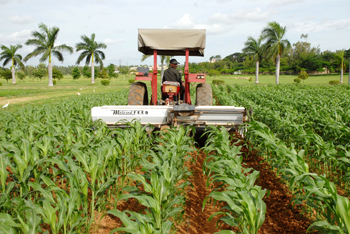Revamping the Agriculture
India is an agro-based economy where more than 50% of its population is directly or indirectly related to agriculture in some or other way. However the sector shares merely 13% to its GDP. Agricultural productivity, fragmentation of land holdings, lack of farm mechanization along others are some of the other challenges which seeks an urgency to revamp the agriculture sector of the country. It is imperative to have a growth which is sustainable and improve the standard of living to those dependent on it. It could be done by restructuring the the existing allocations.
Input based challenges and solutions
The increased use of chemical fertilizer and pesticides not only adds cost to the input to the farmers but is also environmentally unsustainable. Hence there is a need to optimize the use of fertilizer and replace a significant proportion by bio-fertliser and bio-pesticide. Making available the farm mechanization on lease to the farmers as most of them have small land holding. Govt. schemes like National horticulture mission need to be fastracked in the geographically distinct areas focusing on the production of perishables.
Farm extension service though proved to be very useful, but not available everywhere, hence need a revival. The sector needs to be linked to the agriculture advanced nations like Israel, Netherlands etc. There is a need to collaborate the National Dairy Development Board (NDDB) and Small Farmers Agriculture Consortium on a joint mission basis sharing the refrigeration facility for controlling the distribution the essentials such as onions, potatoes and tomatoes to check the fluctuation in the price.
Availability of the credits to the farmers in the distressed monsoons and for the input intensive crops like cotton should be made more farmer-friendly. Also, the poorly lactating breed of the milch animals mainly because of climate and the fodder availability, it is required to set up artificial insemination to double the milk yield along with availability of the vertinary services.
Post-harvest management
A long-term Export-import policies that should be farmer friendly, allowing the exports without any restriction and imports with heavy duty on perishables. It should be in consonance with the trade agreements with different nations not adversely affecting the intrest of the farmer community.
Multiple connecting points between the farmers and the consumers. There should be a revamp and uniform implementation in the APMC act. Food processing industries, agriculture marketing, mega food parks, fixing the distortion in the food procurement, increasing the marketyards for the agriculture are such other measures.
The Apni mandi like space where the farmers directly sell his products to the consumer. Also the need to encourage the private investment in the procurement bypassing the mandis, allows the competition that would ultimately benefit the farmers.
Promoting the horticulture, dairy, poultry and fisheries will not only diversify the agriculture sector and create employment but also reduce the malnutrition in the country. Therefore, in this context dryland farming gains a significance promoting the coarse cereals and therefore the nutritional security.


